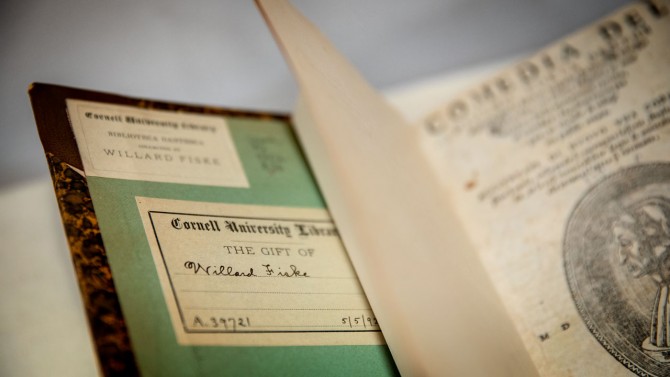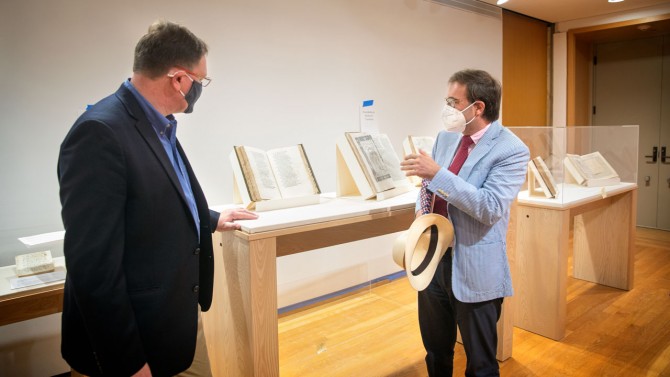In 1892, as Willard Fiske, Cornell's first librarian, was restoring a spacious villa in the hills overlooking Florence, Italy, he bought a small book. It was more than 350 years old with a "sad" binding. He'd later confess that he bought it only because he thought it was unusual - and inexpensive.
The book was 1536 copy of the "Divine Comedy" by the medieval Italian poet Dante Alighieri.
Fiske sent the book to Cornell, downplaying its value in a postcard to interim Cornell Librarian William Harris. "No special value attached to the edition so far as I know," he wrote. "Should the Library already possess a copy, please forward this to the library at Dryden."
This 1536 copy of the "Divine Comedy," donated by Willard Fiske, was the first item in what is now the largest Dante collection in North America: Cornell's Fiske Dante Collection.
That little book was the first of an avalanche of material that now makes up the largest Dante collection in North America - the Fiske Dante Collection, at Cornell University Library's Division of Rare and Manuscript Collections (RMC).
The collection forms the foundation of the "Visions of Dante" exhibition at the Herbert F. Johnson Museum of Art. Marking the 700th anniversary of Dante's death, the exhibition of approximately 100 works in various media explores the visual nature of the "Divine Comedy," which has inspired scholars and artists alike, from medieval times through today.
"A whole group of people - curators but also exhibition coordinators, registrars, conservators, photographers, video technicians and web designers - a joined forces to create one of the largest and most comprehensive exhibitions about Dante in 2021," says exhibition co-curator Laurent Ferri, curator of pre-1800 collections in RMC.
"Visions of Dante" not only puts on display a large portion of the Fiske Collection for the first time. It also brings together works lent by notable institutions like the Morgan Library & Museum and 20th century and contemporary artists from William Blake to Salvador Dalí, Robert Rauschenberg and Kara Walker.
Each piece presents a different take on the "Divine Comedy," in which Dante the narrator finds himself in an allegorical situation that every human can relate to: lost, alone and fearful in a dark wood.
With Virgil and his beloved Beatrice as guides, he travels to Hell, Purgatory and Paradise - described in the poem's three parts "Inferno," "Purgatorio" and "Paradiso." Despite suffering and hardship - or maybe because of them - he emerges to reunite with God.
Exhibition co-curators Andrew C. Weislogel (left), the Johnson Museum's Seymour R. Askin, Jr. '47 Curator of Earlier European and American Art, and Laurent Ferri, curator of pre-1800 collections in the Division of Rare and Manuscript Collections, examine the 1472 copy of the first printed edition of the "Divine Comedy."
"This exhibition reasserts the continued vibrancy of the 'Divine Comedy' as a work of art, a work of literature, and shows the many ways in which visual artists have made their own personal interpretations and translations of that original text," says co-curator Andrew C. Weislogel, the Johnson's Seymour R. Askin, Jr. '47 Curator of Earlier European and American Art.
The exhibition includes outreach programs to help learners of all kinds appreciate its works. Faculty members are encouraged to bring their classes to the exhibition. An Oct. 16 symposium will bring together scholars who will discuss the ongoing impact of Dante as a visual poet. And through the Central New York Humanities Corridor collaboration with the University of Rochester, college students from the region are encouraged to attend.
In 1892, as Willard Fiske, Cornell's first librarian, was restoring a spacious villa in the hills overlooking Florence, Italy, he bought a small book. It was more than 350 years old with a "sad" binding. He'd later confess that he bought it only because he thought it was unusual - and inexpensive.
The book was 1536 copy of the "Divine Comedy" by the medieval Italian poet Dante Alighieri.
Fiske sent the book to Cornell, downplaying its value in a postcard to interim Cornell Librarian William Harris. "No special value attached to the edition so far as I know," he wrote. "Should the Library already possess a copy, please forward this to the library at Dryden."
That little book was the first of an avalanche of material that now makes up the largest Dante collection in North America - the Fiske Dante Collection, at Cornell University Library's Division of Rare and Manuscript Collections (RMC).
The collection forms the foundation of the "Visions of Dante" exhibition at the Herbert F. Johnson Museum of Art. Marking the 700th anniversary of Dante's death, the exhibition of approximately 100 works in various media explores the visual nature of the "Divine Comedy," which has inspired scholars and artists alike, from medieval times through today.
"A whole group of people - curators but also exhibition coordinators, registrars, conservators, photographers, video technicians and web designers - joined forces to create one of the largest and most comprehensive exhibitions about Dante in 2021," says exhibition co-curator Laurent Ferri, curator of pre-1800 collections in RMC.
"Visions of Dante" not only puts on display a large portion of the Fiske Collection for the first time. It also brings together works lent by notable institutions like the Morgan Library & Museum and 20th century and contemporary artists from William Blake to Salvador Dalí, Robert Rauschenberg and Kara Walker.
Each piece presents a different take on the "Divine Comedy," in which Dante the narrator finds himself in an allegorical situation that every human can relate to: lost, alone and fearful in a dark wood.
With Virgil and his beloved Beatrice as guides, he travels to Hell, Purgatory and Paradise - described in the poem's three parts "Inferno," "Purgatorio" and "Paradiso." Despite suffering and hardship - or maybe because of them - he emerges to reunite with God.
"This exhibition reasserts the continued vibrancy of the 'Divine Comedy' as a work of art, a work of literature, and shows the many ways in which visual artists have made their own personal interpretations and translations of that original text," says co-curator Andrew C. Weislogel, the Johnson's Seymour R. Askin, Jr. '47 Curator of Earlier European and American Art.
The exhibition includes outreach programs to help learners of all kinds appreciate its works. Faculty members are encouraged to bring their classes to the exhibition. An Oct. 16 symposium will bring together scholars who will discuss the ongoing impact of Dante as a visual poet. And through the Central New York Humanities Corridor collaboration with the University of Rochester, college students from the region are encouraged to attend.








